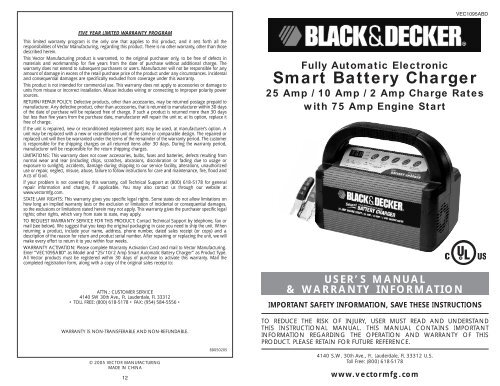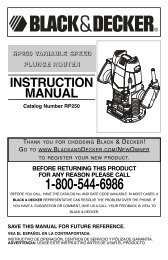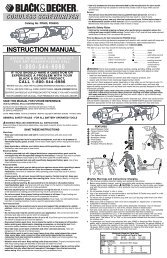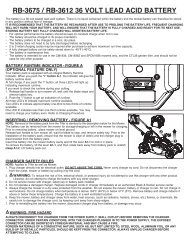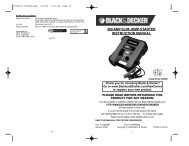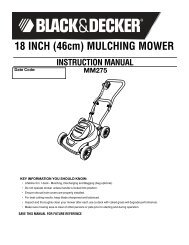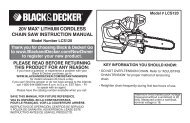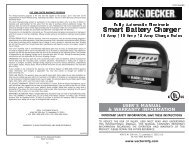Smart Battery Charger - Black & Decker ServiceNet
Smart Battery Charger - Black & Decker ServiceNet
Smart Battery Charger - Black & Decker ServiceNet
You also want an ePaper? Increase the reach of your titles
YUMPU automatically turns print PDFs into web optimized ePapers that Google loves.
VEC1095ABD_Manual_050205 5/5/05 6:35 PM Page 12VEC1095ABDFIVE YEAR LIMITED WARRANTY PROGRAMThis limited warranty program is the only one that applies to this product, and it sets forth all theresponsibilities of Vector Manufacturing, regarding this product. There is no other warranty, other than thosedescribed herein.This Vector Manufacturing product is warranted, to the original purchaser only, to be free of defects inmaterials and workmanship for five years from the date of purchase without additional charge. Thewarranty does not extend to subsequent purchasers or users. Manufacturer will not be responsible for anyamount of damage in excess of the retail purchase price of the product under any circumstances. Incidentaland consequential damages are specifically excluded from coverage under this warranty.This product is not intended for commercial use. This warranty does not apply to accessories or damage tounits from misuse or incorrect installation. Misuse includes wiring or connecting to improper polarity powersources.RETURN/REPAIR POLICY: Defective products, other than accessories, may be returned postage prepaid tomanufacturer. Any defective product, other than accessories, that is returned to manufacturer within 30 daysof the date of purchase will be replaced free of charge. If such a product is returned more than 30 daysbut less than five years from the purchase date, manufacturer will repair the unit or, at its option, replace itfree of charge.If the unit is repaired, new or reconditioned replacement parts may be used, at manufacturer’s option. Aunit may be replaced with a new or reconditioned unit of the same or comparable design. The repaired orreplaced unit will then be warranted under the terms of the remainder of the warranty period. The customeris responsible for the shipping charges on all returned items after 30 days. During the warranty period,manufacturer will be responsible for the return shipping charges.LIMITATIONS: This warranty does not cover accessories, bulbs, fuses and batteries, defects resulting fromnormal wear and tear (including chips, scratches, abrasions, discoloration or fading due to usage orexposure to sunlight), accidents, damage during shipping to our service facility, alterations, unauthorizeduse or repair, neglect, misuse, abuse, failure to follow instructions for care and maintenance, fire, flood andActs of God.If your problem is not covered by this warranty, call Technical Support at (800) 618-5178 for generalrepair information and charges, if applicable. You may also contact us through our website atwww.vectormfg.com.STATE LAW RIGHTS: This warranty gives you specific legal rights. Some states do not allow limitations onhow long an implied warranty lasts or the exclusion or limitation of incidental or consequential damages,so the exclusions or limitations stated herein may not apply. This warranty gives the purchaser specific legalrights; other rights, which vary from state to state, may apply.TO REQUEST WARRANTY SERVICE FOR THIS PRODUCT: Contact Technical Support by telephone, fax ormail (see below). We suggest that you keep the original packaging in case you need to ship the unit. Whenreturning a product, include your name, address, phone number, dated sales receipt (or copy) and adescription of the reason for return and product serial number. After repairing or replacing the unit, we willmake every effort to return it to you within four weeks.WARRANTY ACTIVATION: Please complete Warranty Activation Card and mail to Vector Manufacturing.Enter “VEC1095ABD” as Model and “25/10/2 Amp <strong>Smart</strong> Automatic <strong>Battery</strong> <strong>Charger</strong>” as Product Type.All Vector products must be registered within 30 days of purchase to activate this warranty. Mail thecompleted registration form, along with a copy of the original sales receipt to:ATTN.: CUSTOMER SERVICE4140 SW 30th Ave., Ft. Lauderdale, FL 33312• TOLL FREE: (800) 618-5178 • FAX: (954) 584-5556 •Fully Automatic Electronic<strong>Smart</strong> <strong>Battery</strong> <strong>Charger</strong>25 Amp / 10 Amp / 2 Amp Charge Rateswith 75 Amp Engine StartUSER’S MANUAL& WARRANTY INFORMATIONIMPORTANT SAFETY INFORMATION, SAVE THESE INSTRUCTIONSWARRANTY IS NON-TRANSFERABLE AND NON-REFUNDABLE.© 2005 VECTOR MANUFACTURINGMADE IN CHINA12BD050205TO REDUCE THE RISK OF INJURY, USER MUST READ AND UNDERSTANDTHIS INSTRUCTIONAL MANUAL. THIS MANUAL CONTAINS IMPORTANTINFORMATION REGARDING THE OPERATION AND WARRANTY OF THISPRODUCT. PLEASE RETAIN FOR FUTURE REFERENCE.4140 S.W. 30th Ave., Ft. Lauderdale, FL 33312 U.S.Toll Free: (800) 618-5178www.vectormfg.com
VEC1095ABD_Manual_050205 5/5/05 6:35 PM Page iiIMPORTANT SAFETY INSTRUCTIONSWARNINGS1. RISK OF EXPLOSIVE GAS MIXTURES — WORKING IN VICINITY OF A LEAD-ACIDBATTERY IS DANGEROUS. BATTERIES GENERATE EXPLOSIVE GASES DURINGNORMAL BATTERY OPERATION. FOR THIS REASON, IT IS OF UTMOST IMPORTANCETHAT EACH TIME BEFORE USING YOUR CHARGER, YOU READ THIS MANUAL ANDFOLLOW THE INSTRUCTIONS EXACTLY.2. To reduce risk of battery explosion, follow these instructions and those published bythe battery manufacturer and manufacturer of any equipment you intend to use invicinity of battery. Review cautionary markings on these products and on engine.3. This equipment employs parts (switches, relays, etc.) that produce arcs or sparks.Therefore, if used in a garage or enclosed area, the unit MUST be placed not lessthan 18 inches above the floor.<strong>Battery</strong> Safety1. Use of an attachment not recommended or sold by the battery charger manufacturer may result ina risk of fire, electric shock, or injury to persons.2. To reduce risk of damage to electric plug and cord, pull by plug rather than cord whendisconnecting charger.3. An extension cord should not be used unless absolutely necessary. Use of an improper extensioncord could result in a risk of fire and electric shock, and will void warranty.If an extension cord must be used, make sure:a. that pins on plug of extension cord are the same number, size, and shape as those of plug oncharger;b. that extension cord is properly wired and in good electrical condition; andc. that wire size is AWG#14 (14 gauge) for 100 feet and AWG#12 for distances over 100 feet.4. Do not operate charger with damaged cord or plug — take to a qualified technician forreplacement of the plug or cord immediately.5. Do not operate charger if it has received a sharp blow, been dropped, or otherwise damaged inany way; take it to a qualified service technician.6. Do not disassemble charger; take it to a qualified service technician when service or repair isrequired. Incorrect reassembly may result in a risk of electric shock or fire, and will void warranty.7. To reduce risk of electric shock, unplug charger from outlet before attempting any maintenance orcleaning. Turning off controls without unplugging will not reduce this risk.8. Do not expose charger to rain, snow or use when wet.Personal Safety1. Another person should be within range of your voice or close enough to come to your aid whenyou work near a lead-acid battery.2. Fresh water and soap should be nearby in case battery acid contacts skin, clothing, or eyes.3. Wear complete eye protection and clothing protection. Avoid touching eyes while working with abattery. Acid, acid particles or corrosion may get into eyes. Immediately flood eye with cold water(Eye Wash Station) for at least 15 minutes and seek medical attention immediately.4. If battery acid contacts skin or clothing, wash immediately with soap and water. If redness, pain orirritation occurs, seek immediate medical attention.5. NEVER smoke or allow a spark or flame in vicinity of battery or engine.6. Be extra cautious to reduce the risk of dropping a metal tool onto battery. This might cause sparksor short-circuit the battery or other electrical part, which can cause an explosion.7. Remove personal metal items such as rings, bracelets, necklaces and watches when working witha lead-acid battery. A lead-acid battery can produce a short-circuit current high enough to cause asevere burn.8. Use charger for charging a LEAD-ACID battery only. It is not intended to supply power to a lowvoltageelectrical system other than in a starter-motor application. Do not use the battery chargerfor charging dry-cell batteries that are commonly used with home appliances. These batteries mayburst and cause injury to persons and damage property.9. NEVER ATTEMPT TO CHARGE A FROZEN BATTERY.Power Cord Safety<strong>Charger</strong> should be grounded to reduce risk of electric shock. <strong>Charger</strong> is equipped with an AC cord havingequipment-grounding conductor and a grounding plug. The plug must be plugged into a properly installedand grounded 110/120 volt AC outlet in accordance with all local codes and ordinances (see Figure 1A).Figure1AGROUNDINGPIN (A)Figure1BADAPTER (B)GROUNDINGMEANSMETAL SCREWIf a properly grounded outlet is not available, a temporary adapter (like the adapter shown in Figure1B)may be used to connect this plug to a two-pole receptacle. The temporary adapter should be used ONLYuntil a properly grounded outlet can be installed by a qualified electrician.DANGER — Before using an adapter as illustrated, make certain that the center screwof outlet plate is grounded.The green-colored rigid ear or tab extending from adapter must be connected to a properly groundedoutlet. MAKE CERTAIN IT IS GROUNDED. If necessary, replace original outlet cover plate screw with alonger screw that will secure adapter ground tab to outlet cover plate and connect to grounded outlet.WARNINGNEVER alter AC cord or plug. If it will not fit, have a proper outlet installed by aqualified electrician. Improper connection may result in an electric shock.Note: Use of an adapter is not allowed in Canada. If a grounding type receptacle isnot available, do not use this appliance until the proper outlet has beeninstalled by a qualified electrician.Preparing to Charge1. Determine voltage of battery to be charged by referring to the vehicle manual.2. If it is necessary to remove battery from vehicle to charge, or to clean terminals, always removegrounded terminal from battery first. Make sure all accessories in the vehicle are off, so as not tocause an arc.3. Clean battery terminals. Do not allow corrosion to come in contact with eyes.4. Add distilled water in each cell until battery acid reaches level specified by battery manufacturer.This helps purge excessive gas from cells. Do not overfill. For a battery without cell caps(maintenance free), carefully follow manufacturer's charging instructions.5. Study all battery manufacturer’s specific precautions, such as removing or not removing cell capswhile charging, and recommended rates of charge.6. Area around battery should be well ventilated while battery is being charged. Gas can be forcefullyblown away by using a piece of cardboard or other nonmetallic material as a fan.7. Make sure the initial charging rate does not exceed battery manufacturer’s requirement.<strong>Charger</strong> Location1. Locate charger as far away from battery as cables permit.2. NEVER place charger directly above battery being charged; gases from battery will corrode anddamage charger.3. NEVER allow battery acid to drip on charger when reading gravity or filling battery.4. NEVER operate charger in a closed-in area or restrict ventilation in any way.5. Marine batteries must be removed and charged on shore.6. Do not set a battery on top of charger.DC Connection Precautions1. Connect and disconnect DC output clamps only after removing AC cord from electric outlet.2. Never allow clamps to touch each other.3. Attach clamps to battery chassis as indicated in “<strong>Battery</strong> Installed in Vehicle” steps 5 and 6, andin “<strong>Battery</strong> Outside of Vehicle” steps 2, 4 and 5.Follow these steps when the battery is installed in a vehicle. A spark near the batterymay cause an explosion. To reduce risk of a spark near the battery:1. Position AC and DC cords to reduce risk of damage by hood, door, or moving engine part.2. Stay clear of fan blades, belts, pulleys, and other parts that can cause injury to persons.3. Check polarity of battery posts. POSITIVE (POS, P, +) battery post usually has larger diameter thanNEGATIVE (NEG, N, –) post.4. Determine which post of battery is grounded (connected) to the chassis. If NEGATIVE post isgrounded to chassis (as in most vehicles), see 5. If POSITIVE post is grounded to the chassis, see 6.iii
VEC1095ABD_Manual_050205 5/5/05 6:35 PM Page iv5. For negative-grounded vehicle, connect POSITIVE (RED) clamp from battery charger to POSITIVE(POS, P, +) ungrounded post of battery. Connect NEGATIVE (BLACK) clamp to vehicle chassis orengine block away from battery. Do not connect clip to carburetor, fuel lines, or sheet-metal bodyparts. Connect to heavy gauge metal part of the frame or engine block.6. For positive-grounded vehicle, connect NEGATIVE (BLACK) clamp from battery charger toNEGATIVE (NEG, N, –) ungrounded post of battery. Connect POSITIVE (RED) clamp to vehiclechassis or engine block away from battery. Do not connect clip to carburetor, fuel lines or sheetmetalbody parts. Connect to a heavy gauge metal part of the frame or engine block.7. When disconnecting charger, disconnect AC cord, remove clamp from vehicle chassis, and thenremove clamp from battery terminal.8. Do not charge the battery while the engine is operating.9. See operating instructions for length of charge information.Follow these steps when the battery has been removed from a vehicle. A spark nearthe battery may cause an explosion. To reduce risk of a spark near the battery:1. Check polarity of battery posts. The POSITIVE post (marked POS,P, +) usually has a larger diameterthan the NEGATIVE battery post (marked NEG, N, –).2. Attach a 24-inch (minimum length) 6 AWG insulated battery cable to the NEGATIVE battery post(marked NEG, N, –).3. Connect the POSITIVE (RED) battery clamp to the POSITIVE battery post (marked POS, P, + or red).4. Stand as far back from the battery as possible, and do not face battery when making finalconnection.5. Carefully connect the NEGATIVE (BLACK) charger clamp to the free end of the battery cableconnected to the NEGATIVE terminal.6. Set the charge rate to appropriate setting according to battery size.7. When disconnecting charger, always do so in reverse sequence of connecting procedure and breakfirst connection while as far away from battery as practical.Note: A marine (boat) battery must be removed and charged on shore. To charge iton board requires equipment specially designed for marine use. This unit isNOT designed for such use.SAVE THESE INSTRUCTIONSThis device complies with part 15 of the FCC rules. Operation is subject to the following twoconditions: (1) this device may not cause harmful interference, and (2) this device must acceptany interference received, including interference that may cause undesired operation.This equipment has been tested and found to comply with the limits for a Class B digital device,pursuant to part 15 of the FCC Rules. These limits are designed to provide reasonable protectionagainst harmful interference in a residential installation. This equipment generates, uses and canradiate radio frequency energy and, if not installed and used in accordance with theinstructions, may cause harmful interference to radio communications. However, there is noguarantee that interference will not occur in a particular installation. If equipment does causeharmful interference to radio or television reception, which can be determined by turning theequipment off and on, the user is encouraged to try to correct the interference by one or moreof the following measures:• Reorient or relocate the receiving antenna.• Increase the separation between equipment and receiver.• Connect the equipment into an outlet on a circuit different from that to which the receiver isconnected.• Consult the dealer or an experienced radio/TV technician for help.TABLE OF CONTENTSIntroduction . . . . . . . . . . . . . . . . . . . . . . . . . . . . . . . . . . . . . . . . . . . . . . . . . . . . 1Features . . . . . . . . . . . . . . . . . . . . . . . . . . . . . . . . . . . . . . . . . . . . . . . . . . . . . . 2Controls and Indicators . . . . . . . . . . . . . . . . . . . . . . . . . . . . . . . . . . . . . . . . . 3Operating Instructions . . . . . . . . . . . . . . . . . . . . . . . . . . . . . . . . . . . . . . . . . . . . 5Charge Rate Selection . . . . . . . . . . . . . . . . . . . . . . . . . . . . . . . . . . . . . . . . . . 5Charging the <strong>Battery</strong> . . . . . . . . . . . . . . . . . . . . . . . . . . . . . . . . . . . . . . . . . . . 5Automatic Float Charging . . . . . . . . . . . . . . . . . . . . . . . . . . . . . . . . . . . . . . . . 6Equalizing . . . . . . . . . . . . . . . . . . . . . . . . . . . . . . . . . . . . . . . . . . . . . . . . . . . 6Engine Start . . . . . . . . . . . . . . . . . . . . . . . . . . . . . . . . . . . . . . . . . . . . . . . . . 7Recondition Mode . . . . . . . . . . . . . . . . . . . . . . . . . . . . . . . . . . . . . . . . . . . . . 7Alternator Check . . . . . . . . . . . . . . . . . . . . . . . . . . . . . . . . . . . . . . . . . . . . . . 8Approximate Charging Times . . . . . . . . . . . . . . . . . . . . . . . . . . . . . . . . . . . . . . . 9Care and Maintenance . . . . . . . . . . . . . . . . . . . . . . . . . . . . . . . . . . . . . . . . . . . 9Troubleshooting . . . . . . . . . . . . . . . . . . . . . . . . . . . . . . . . . . . . . . . . . . . . . . . . 10INTRODUCTIONThank you for selecting the <strong>Black</strong> & <strong>Decker</strong> 25/10/2 Amp <strong>Smart</strong> <strong>Battery</strong><strong>Charger</strong>. With proper care and use, it will give you years of dependable service.This battery charger has a high charge rate of up to 25 amps, a low charge rateof 2 amps and 75 amps of engine starting power. It is designed for charging only12 volt lead-acid batteries — conventional automotive, maintenance-free, marinedeep cycle and gel — used in cars, trucks, farm equipment, boats, RVs and SUVs,lawn mowers/garden tractors, motorcycles, personal watercraft, snowmobiles, ATVsand various applications.<strong>Smart</strong> <strong>Battery</strong> <strong>Charger</strong>s feature 3-stage high-efficiency charging technology built-inmicroprocessor control that ensures fast, safe and complete charging of serviceablebatteries.Charge CurveBEEPSTAGE ONEBEEPSTAGE TWOOFF BEEPSTAGE THREECHARGINGCOMPLETEStage One — Rapid Start Charge at 25 amps delivers maximum chargingamperage to “wake up” any serviceable 12 volt battery and allows for quick enginestarting. When battery reaches a maximum safe predetermined voltage, the chargerwill automatically signal a "beep" and move into Stage 2 of the charging process.iv1
VEC1095ABD_Manual_050205 5/5/05 6:35 PM Page 2Stage Two — Absorption Charge maintains the maximum possible charge at aconstant, safe, predetermined voltage. During this phase, the charging voltageremains constant, while the actual charging current is reduced to allow for themaximum proper internal chemical energy transfer. At the end of Stage 2, the chargerwill automatically move into Stage 3 charge mode.Stage Three — Top-Off Charge — voltage is automatically maintained andreduced to a predetermined level while current is adjusted for a safe, effective batterycharge. At the conclusion of Stage 3, the unit will BEEP signaling the completion ofthe charging cycle.The Automatic Float Charge feature is ideal for maintaining a battery. It automaticallytops off battery as needed to keep battery fully charged all the time.FEATURES• This unit has three charge rate settings, accessed by the 2/10/25 AMP button:a) 2 amps: smaller batteries, such as in lawn mowers, snowmobiles, motorcycles,etc.b) 10 amps: mid-sized batteries, such as in small carsc) 25 amps: automobiles and light trucks• 75 amp engine start• Automatic Temperature Compensation• <strong>Battery</strong> type selection• Digital diagnostics• Alternator voltage and battery voltage check• Digital display shows charge rate, operating mode, fault codes and FUL whencharged• 1-minute engine start• 3-stage high-frequency switch mode automatic rapid charging• Spark resistant reverse polarity and short circuit protection for user• Built-in battery reconditioning (desulfate)• Lightweight, high-efficiency design• Internal short circuit protection• Cables and clamps self-stored• Reverse polarity indication• Microprocessor control (Digital <strong>Smart</strong> Control)/High frequency power• Compensates for low AC from extension cord use• Equalization functionControls and IndicatorsCONTROL PANELDIGITAL READOUTCIRCULATING PATTERNFUNCTION BUTTONS (FROM LEFT TO RIGHT):<strong>Battery</strong> Type (Step 1) — allows the user to select Wet, Gel or AGM type of batteryfor efficient and safe charge. Most automotive batteries are Wet batteries. Refer to thebattery manufacturer’s specifications for battery type.2/10/25A AMP (Charge Rate Selector) (Step 2) — allows the user to selectthe charge rate based on battery size. This selection and the actual battery chargerate are monitored by the microprocessor. The charger will stop charging if the rateis too fast or too slow for the battery size or condition.75 AMP Engine Start — places the charger in an engine start sequence. Thisbutton will not be activated unless the charger is in the 25 amp charge mode; set the2/10/25 AMP button to 25 amps first to activate this button.<strong>Battery</strong> Recondition — is an automatic mode that, once started, continues for 24hours and then stops. A series of electrical pulses breaks the crystalline form of leadsulfate to return these chemicals into useful battery electrolytes. More than 24 hoursmay be needed to restore. Periodic reconditioning is recommended to maintain abattery's optimum performance. However, if 5 cycles does not improve batteryperformance, discontinue and recycle the battery.<strong>Battery</strong> Voltage (Alternator Voltage Check) — is a quick check that measuresthe battery voltage. This check is repeated at various electrical load levels and thetests allow the user to determine if the alternator can keep up with the loads.INDICATOR:Large (.375”) 3-Character Digital Display in the upper left of the control panelindicates the various conditions and/or status codes:23
VEC1095ABD_Manual_050205 5/5/05 6:35 PM Page 4Status Codes are described in the following chart and on the back of charger.AC POWER INDICATOR - When connected to an AC outlet, digital display shows circulating pattern toindicate power is on. Disconnect charger after use.FAULT CODESF01 INTERNAL SHORTED CELL BATTERY - Cannot be charged. Have battery checked by certified auto service center.EXCESSIVE LOAD ON BATTERY WHILE CHARGING - Check load.F02 BAD BATTERY CONNECTION - Check battery connection.BATTERY VOLTAGE TOO LOW TO ACCEPT CHARGE - Have battery checked by certified auto service center.F03 INTERNAL OPEN CELL - Have battery checked by certified auto service center.SULFATED CONDITION - <strong>Battery</strong> needs to be reconditioned. See manual.F04 OVERTIME CONDITION - <strong>Battery</strong> will not accept a charge after 18 hours of continuous charging. <strong>Battery</strong> may haveinternal damage. Have battery checked by certified auto center.BATTERY CHARGE RATE IS SET TOO LOW - Set charger to higher charge rate. See manual.F05 OVERHEATED CONDITION - Disconnect charger and allow to cool for 30 min., check for ample ventilation.F06 REVERSE POLARITYF07 ALTERNATOR OUTPUT IS OUT OF TYPICAL OPERATION RANGEOPERATION CODESBATTERY RECONDITIONING - (The letters DES will display for the first 3 seconds.)000FULALTERNATOR VOLTAGE CHECKCHARGER STANDBYBATTERY FULLY CHARGEDCONTROL PANEL LED INDICATORS:WET — lights when battery type selector is on WET battery typeGEL — lights when battery type selector is on GEL battery typeAGM — lights when battery type selector is on AGM battery type.Float Charge — lights when automatic charge monitoring is active. This featureallows a battery to maintain its charge over long periods of non-use. If there is anyloss of power to the charger once power is restored, charger will automatically returnto the default settings. <strong>Battery</strong> selector type would be “GEL”.<strong>Battery</strong> Voltage — lights when battery voltage is displayed.Alternator Good — lights when load or no load checks show the alternator iskeeping up with the electrical load.Equalize — a recessed button used to start the equalize process.OPERATING INSTRUCTIONSEnsure that all installation and operating instructions and safetyprecautions are understood and carefully followed by anyoneinstalling or using the charger. Follow the steps outlined in “ImportantSafety Instructions” at the front of this manual.Charge Rate SelectionAfter charger clamps are correctly connected, plug in the charger to a 120 volt ACoutlet. The charger will show a circulating pattern on the Digital Display, indicatingpower has been applied. Select the proper charge current rate based on battery size.Press the 2/10/25 AMP button and the charger will begin charging at 2 amps.Pressing the 2/10/25 AMP button again will advance the charge rate to 10 amps,and again to 25 amps. Pressing the switch again will turn OFF the charger outputand the display will show “000”.Note: The only time the selected charge rate does not display at the full selected rateis when the battery is nearly full and charging at either step two or three. Thedisplay will be showing a reduced charge rate. To return to 2A, press the2/10/25 AMP button. When the battery is fully charged, the charging completeand “FUL” is displayed on the Digital Display.WARNINGIf Digital Display shows “F02” and the Fault indicator lights, theconnection to the battery terminals is bad. Follow the steps outlined in“Important Safety Instructions” at the front of this manual todisconnect, clean battery terminals, then reconnect.If Digital Display shows “F06”, the Red (POSITIVE) and <strong>Black</strong>(NEGATIVE) clamps are incorrectly connected to battery terminals.Follow the steps outlined in “Important Safety Instructions” at thefront of this manual to disconnect, then reconnect in correct polarity.Charging the <strong>Battery</strong>1. Press <strong>Battery</strong> Type selector until desired battery type LED lights.Note: The default selection is “GEL” type battery.2. Press 2/10/25 AMP button to begin charging at the 2 amp rate; the unit soundsa beep and the charging current LED lights. The charger starts charging at 2 amprate automatically if 2/10/25 AMP button is not pressed within 3 minutes afterapplying AC power.If the Display on the charger varies between “F03” and the amp rate, the batteryis sulfated and the charger is trying to give it some charge. If after approximately2 hours the display just shows “F03”, then the battery will not charge.<strong>Charger</strong> occasionally sounds a beep and displays “0.0” during self-test orcharging stage changes.3. Pressing the 2/10/25 AMP button again advances charging rate to 10 amps,and pressing once more advances charging rate to 25 amps. (Pressing the buttonagain will turn OFF the charger output and the Display will show “000”.) Thisselection and actual battery charge rate are monitored by the microprocessor,and the unit will stop charging if the selected rate is too fast or too slow for batterysize or condition.45
VEC1095ABD_Manual_050205 5/5/05 6:35 PM Page 6As the battery nears full charge capacity, the unit’s output will automatically dropto a lower charge rate.Pressing the 2/10/25 AMP button repeatedly advances to standby mode; theunit sounds a beep, displays “000” and stops charging.4. The battery charger displays the charge current. To view the battery voltage,press BATTERY VOLTAGE button. The charger will sound a beep and display thebattery voltage for 3 seconds, then returns to displaying the charge current.5. The display shows “FUL” when the battery is fully charged.6. Follow the steps outlined in “Important Safety Instructions” at the front of thismanual to disconnect.Automatic Float ChargingAutomatic Float Charging is ideal for maintaining a fully charged battery.1. Keep the AC power and battery connected after battery is fully charged.2. The charger monitors the battery and tops it off as needed.3. The Float Charge indicator lights and the display shows charge current whentopping off the battery and returns to “FUL” when completed.4. To view battery voltage, press the <strong>Battery</strong> Voltage button.Note: Charging can be terminated by pressing the charge rate selector button at anytime when unit is charging. After AC power interruption, charging restarts at2 amp rate automatically and the battery type will default to “GEL”.WARNINGIf battery size is not known, charge at the 2 amp rate. DO NOTovercharge batteries.EqualizingEqualizing is the process by which the fluid in each of a battery’s cells is equalized.This process occurs after charging is complete.WARNINGS• NEVER TRY TO EQUALIZE A GEL OR AGM CELL. THE RESULTINGEXPLOSION COULD CAUSE PROPERTY DAMAGE, SERIOUS INJURYAND/OR DEATH.• Remove or disconnect the vehicle’s battery when equalizing.The frequency which the equalization process needs to be run depends on the use ofthe battery. The more the battery is used, the more undercharged it becomes; thus themore frequently the battery should be equalized.1. Do not use this mode on sealed or valve regulated batteries. This mode is onlymeant for wet (unsealed/vented) batteries.2. Make sure there are no flammable sources near the recharging sight.3. Wear safety glasses, gloves and protective clothing.4. Remove battery from vehicle. MAKE SURE THAT THE BATTERY HAS GOODVENTILATION. The process causes the release of hydrogen and oxygen. Anaccumulation of these gases presents a real danger of explosion.5. Open the battery cap, if removable.6. Fill the battery with distilled water according to the manufacturer’s instructions.Since batteries may rapidly bubble while being charged, remember to refill (onlywith distilled water) after the equalization process is complete and the voltage isback to normal.7. Follow the steps in the “Charging the <strong>Battery</strong>” section on page 5 of this manual.8. Push the <strong>Battery</strong> Type Selector Switch until “WET” is displayed. (This mode willonly work if a WET battery is selected.)9. Choose the correct charge rate and start charging. You can check the batteryvoltage by pushing the <strong>Battery</strong> Voltage button. This will trigger the <strong>Battery</strong> Voltageindicator button.10. Push the Equalize button at any time and the battery will automatically begin toequalize in 4 amp limited current. Note that in order to push the recessed buttonyou will need a small pin or ballpoint pen.11. Every hour, the temperature should be checked by touching the battery. If thebattery is hot to the touch, stop the charging and allow the battery to cool.12. The voltage rises, but does not go over 15.3v to 16.2v (2.55-2.7v per cell)depending on ambient temperature, it will automatically adjust.13. The “WET” LED flashes while the charger is in equalize mode.14. The digital readout will show “FUL” when the equalization process is complete.Engine StartThe Engine Start function can supply 75 amps for engine starting.1. Set the 2/10/25 AMPS button to 25 amp mode and immediately press the 75Abutton switch to activate the Engine Start mode.2. The digital display will countdown from “999” to “000.”3. When the “000” count is reached and begins flashing on the Display, the vehicleis ready to start.4. Crank the engine using manufacturer’s guidelines, typically in 3 to 5 secondbursts. The high current engine starting function requires a resting/cooling periodbetween tries. The charger will switch back to regular charge mode after5 seconds and will not allow operation in this mode for 4 minutes. Wait 4 to 5minutes before a second attempt at starting the engine, if needed.5. During the rest period, the battery is charging at 25 amps. After engine starts,follow the steps outlined in “Important Safety Instructions” at the front of thismanual to disconnect.Recondition ModeWhenever a lead-acid battery begins to discharge, lead sulfate, an insulator, beginsto build up on the battery’s internal plates. This reduces the ability of the battery tohold a full charge. When that battery has an immediate charge, most of the leadsulfate is dissolved and the plates are free of this insulation. If a battery remains in adischarged condition over a longer period of time, the lead sulfate changes to a hardcrystalline form, making a full charge difficult to achieve. Reconditioning may “save”a sulfated battery.BATTERY RECONDITION MODE should only be used with 10 Amp Hour (Ah) orlarger capacity lead-acid batteries. Charge the battery to be treated for 20 minutes,67
VEC1095ABD_Manual_050205 5/5/05 6:35 PM Page 8before using RECONDITION Mode. Observe the Digital Display for any codes. Thisinitial charge will check the battery for shorted cells (F01), open cells (F03) or batterytoo low to accept a charge (F02), and to ensure the battery can take a charge. Ifcode (F03) is displayed, change to the BATTERY RECONDITION MODE.Remove or disconnect the vehicle’s battery when reconditioning.1. Make sure the charger is in initiation state with a circulating pattern on thedisplay or in charge OFF mode with “000” on the display. If not, press 2/10/25AMP button repeatedly until “000” shows on the display.2. Press the <strong>Battery</strong> Recondition button to start the process.3. DES appears on the display for 3 seconds, then it changes to three horizontalmoving bars.4. The process takes 24 hours and stops automatically. The display shows “000”when complete.Alternator CheckPart 1No Load(Turn OFF all vehicle’s accessories): The battery must be fully chargedbefore testing the alternator. Run the engine long enough to achievenormal idle speed and verify there is a no-load voltage.1. Press Alternator Check to start the check.2. Alternator Good LED will light to indicate the alternator is good, orF07 will display to indicate the alternator is out of typical voltagerange.3. Press Alternator Check again to stop the test.Part 2Under Load (Accessories ON): Next, load the alternator by turning on as manyaccessories as possible (except for A/C and DEFROST)1. Press Alternator Check to start the check.2. Alternator Good LED will light to indicate the alternator is good, orF07 will display to indicate the alternator is out of typical voltagerange.3. Press Alternator Check again to stop the test.If the first alternator check indicates a good alternator and the second indicates thealternator is not good, the problem could stem from: loose fan belts, an intermittentdiode failure or possibly bad connections between the battery and alternatorand/or ground.Notes:BATTERY VOLTAGE button is disabled in Alternator Check mode.F07 LED may display because someone has added a number of accessoryloads on the charging system, thereby increasing current demand from thealternator. MAKE SURE THAT THE ALTERNATOR IS RATED TO SUPPORT THEAPPLICATION.This check may not be accurate for every make, manufacturer and model ofvehicle.Check only 12 volt systems.APPROXIMATE CHARGING TIMESThe 25/10/2 Amp <strong>Smart</strong> <strong>Battery</strong> <strong>Charger</strong> will automatically adjust the chargerate as the battery becomes charged and stop when the battery is fully charged. Deepcycle batteries may require longer charging time.For estimates of the time it takes to charge a battery, refer to the following table.Percent of chargein battery 75% 50% 25% 0%at 2 amp rate 7 HRS 14 HRS NR* NR*at 10 amp rate 1.4 HRS 2.8 HRS 4.2 HRS 5.5 HRSat 25 Amp rate 1 HR 1.2 HRS 1.7 HRS 2.2 HRS*NR = Not recommended at 2 amps — use a higher charge rate.The times shown in the table above are approximate and refer to a 50 Ah automotivebattery. For example, a 50 Ah (12 volt) battery is discharged (50%). How longshould it be charged at the 10 amp rate? See the chart above under “50%” and “at10 amp rate.”In most cases, battery charging times will vary depending on the size, age andcondition of the battery. Smaller batteries should be charged at a lower rate (2 amps)and an extra hour added to charge time.CARE AND MAINTENANCEWith proper care and minimal maintenance, the 25/10/2 Amp <strong>Smart</strong> <strong>Battery</strong><strong>Charger</strong> will provide years of dependable service. For maximum performance,manufacturer recommends:• After each use, clean the battery charger clamps — be sure to remove any batteryfluid that will cause corrosion of the clamps.• Clean the outside case of the charger with a soft cloth and, if necessary, mild soapsolution.• Do not allow liquid to enter the charger. Do not operate when charger is wet.• Keep the charger cords loosely coiled during storage to prevent damage to thecords.WARNINGS• Do not use charger if cords or clamps have been damaged in anyway — call Technical Support toll-free at (800) 618-5178.• There are no user-serviceable parts in this unit.• Do not open the unit. In the event of malfunction, it must be returnedto manufacturer for professional testing and repair. OPENING THEUNIT WILL VOID THE MANUFACTURER’S WARRANTY.89
VEC1095ABD_Manual_050205 5/5/05 6:35 PM Page 10TROUBLESHOOTINGDisplay Indications/Common Problems/Possible SolutionsNo Functions• Check and make sure the charger is plugged into a live 110/120 volt AC outlet.• Follow the steps outlined in the Operating Instructions section.F01 — Internal Shorted Cell <strong>Battery</strong>If the battery being charged has an internal shorted cell, the F01 will show. Werecommend taking your battery to a certified automotive service center for evaluation.F02 — Bad <strong>Battery</strong> Connection or <strong>Battery</strong> Voltage Too Low to AcceptChargeWhen F02 appears, the most common cause is poor connection to battery.• Follow the steps outlined in “Important Safety Instructions” at the front of this manualto disconnect AC cord and clamps, clean battery terminal and reconnect.• If the situation persists, we recommend taking your battery to a certified automotiveservice center for evaluation.F03 — Sulfate or Unchargeable <strong>Battery</strong>Appears when the battery is highly sulfated and cannot accept normal charge current.• Follow the steps in “Recondition Mode” to recondition the battery.• Follow the steps in “Equalizing” to equalize the battery.• If the situation persists after reconditioning and equalizing, we recommend takingyour battery to a certified automotive service center for evaluation.F04 — Overtime ConditionAppears when charging time exceeds 18 hours. You may be using a charge currentrate too low for a large battery. Select higher charge rate to charge the battery.F05 — Overheated ConditionThe ventilation grill that prevents the air from flowing in and out of the charger maybe blocked.• Follow the steps outlined in “Important Safety Instructions” at the front of this manual todisconnect AC cord and clamps, allow the unit to cool for 30 minutes and reconnect.• Make sure there is ample ventilation before resuming operation.F06 — Reverse PolarityThe connections to the battery’s POSITIVE and NEGATIVE terminals are incorrect.Follow the steps outlined in “Important Safety Instructions” at the front of this manualto disconnect AC cord and clamps and reconnect to battery with correct polarity.F07 — Alternator VoltageAlternator output voltage is out of typical operation range.Charging a Very Cold <strong>Battery</strong>If the battery to be charged is very cold (in temperatures below freezing — 0°C/ 32°F),it cannot accept a high rate of charge. The initial charge rate will be low. The chargerate will increase as the battery warms. Never attempt to charge a frozen battery.1011


